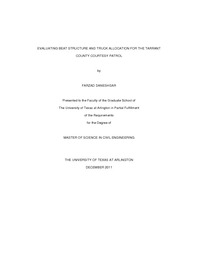
ATTENTION: The works hosted here are being migrated to a new repository that will consolidate resources, improve discoverability, and better show UTA's research impact on the global community. We will update authors as the migration progresses. Please see MavMatrix for more information.
Show simple item record
| dc.contributor.author | Daneshgar, Farzad | en_US |
| dc.date.accessioned | 2012-04-11T20:58:10Z | |
| dc.date.available | 2012-04-11T20:58:10Z | |
| dc.date.issued | 2012-04-11 | |
| dc.date.submitted | January 2011 | en_US |
| dc.identifier.other | DISS-11520 | en_US |
| dc.identifier.uri | http://hdl.handle.net/10106/9624 | |
| dc.description.abstract | Non-recurring congestion poses a significant concern to urban freeway drivers. Effective incident management relies on many tools to lessen the overall impact of crashes, road debris, and stalled/disabled vehicles. While many of the tools are based in a region's traffic management center, many urban areas have adopted freeway service patrol (FSP) programs that patrol the freeway network searching for incidents, providing aid to motorists, and assisting with incident management and clearance. While FSP operations can be assessed in terms of response and clearance times, FSP management must consider the beat structure and fleet allocation. This investigation considers response time and fleet allocation. This study uses both deterministic and probabilistic response time estimations for each beat to assess different fleet allocations. The research's goal is to consider whether the urban network should be segmented into as many beats as possible with individual trucks assigned to each beat or if additional trucks should be allocated to fewer beats.In an effort to explore the truck allocation problem with field data, the study uses the Tarrant County Courtesy Patrol (CP) as a case study. The Tarrant County CP typically uses a one-beat, two-beat or three-beat configuration with a single truck allocated to each beat. This study explores the merits of adding an additional truck to a beat in the two-beat configuration rather than expanding to the three-beat configuration; remaining in the two-beat configuration shows an improvement in estimated response time of four to nine percent. Although the deterministic case shows better performance for the one-beat configuration rather than changing to a two or three beat configuration, the probabilistic case indicates the superiority of the two-beat configuration. This emphasizes the importance of utilizing a probabilistic approach for evaluation. Furthermore, the two-beat configuration appears to perform better because links that are traversed more frequently tend to have more incident per mile than those for other beat configurations. This finding indicates that the incident distribution should be considered during both beat and tour design. | en_US |
| dc.description.sponsorship | Mattingly, Stephen P. | en_US |
| dc.language.iso | en | en_US |
| dc.publisher | Civil & Environmental Engineering | en_US |
| dc.title | Evaluating Beat Structure And Truck Allocation For The Tarrant County Courtesy Patrol | en_US |
| dc.type | M.S. | en_US |
| dc.contributor.committeeChair | Mattingly, Stephen P. | en_US |
| dc.degree.department | Civil & Environmental Engineering | en_US |
| dc.degree.discipline | Civil & Environmental Engineering | en_US |
| dc.degree.grantor | University of Texas at Arlington | en_US |
| dc.degree.level | masters | en_US |
| dc.degree.name | M.S. | en_US |
Files in this item
- Name:
- Daneshgar_uta_2502M_11520.pdf
- Size:
- 6.048Mb
- Format:
- PDF
This item appears in the following Collection(s)
Show simple item record


